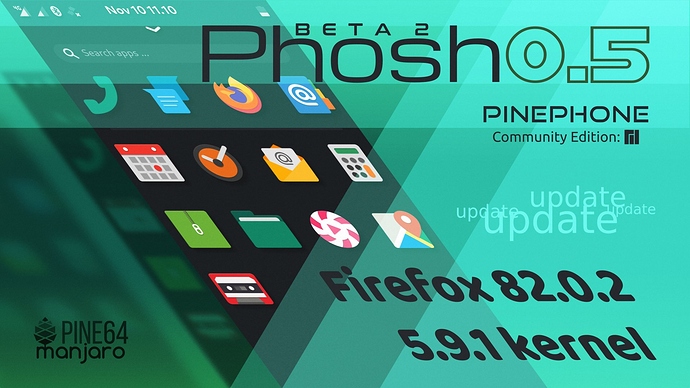Manjaro ARM Beta2 of Phosh for PinePhone!
The Manjaro ARM project is proud to announce our second BETA release for the PinePhone running Phosh!
This image is running the 5.9 kernel from Samuel Holland / linux · GitLab, which is designed for the PinePhone.
Features:
- Firefox uses a dedicated configuration and plays videos on Youtube pretty well
- Camera app with access to back and front camera, including autofocus
- Auto-Rotate function we had to remove
- Welcome wizard for easy setup of the device
- We have now a working Torch in the quick-access-menu
- Prime phone functions working, including resume from deep-sleep and free speaking
- Recording of audio works
- Most applications got added to
scale-to-fit - Haptic feedback functions are given
- Optimized keyboard layout for terminal
- Maps with working GPS
- Volume buttons working
- Sensors fully functional
- Easy access to Bluetooth, Wlan, Rotate and Mobile functions via quick settings
- Default branch is
arm-stable. This can be changed by editing/etc/pacman-mirrors.conf - This image uses a Crust enabled uboot
Changes since Beta1
- based on stable branch
- updated kernel to 5.9.1 with better sound-stack
- updated ALSA-UCM profiles for kernel 5.9 series
- Gnome 3.38.1 updates
- updated Network- and ModemManager
- updated Phosh, Phoc and Squeekboard
- updated packages: alsa, firefox, freetype, mesa, phosh, phoc, squeekboard, gstreamer, chatty
- geary-mobile removed
- enable 60 FPS
- fix HDMI output
- torch works now with upower
- usage of callaudiod for better audio experience with calls
Security notice:
- update your system to the latest kernel to fix bluetooth bleeding tooth issue
Currently broken:
- N/A
Known issues
- it may take longer to wake up from deep-sleep mode when a call is incoming. Most of the time that call will vibrate only.
- UI becomes unresponsive after a while.
- Lots of apps are still missing or are not mobile friendly yet.
Download:
| Device | Phosh |
|---|---|
| PinePhone | Beta2 |
About the device:
PinePhone:
Perhaps you’re in a line of work where security is a must, or a hard-core Linux enthusiast, or perhaps you’ve just got enough of Android and iOS and you’re ready for something else – the PinePhone may be the next Phone for you. Powered by the same Quad-Core ARM Cortex A53 64-Bit SOC used in our popular PINE A64 Single Board Computer, the PinePhone runs mainline Linux as well as anything else you’ll get it to run.
The purpose of the PinePhone isn’t only to deliver a functioning Linux phone to end-users, but also to actively create a market for such a device, as well as to support existing and well established Linux-on-Phone projects. All major Linux Phone-oriented projects, as well as other FOSS OS’, are represented on the PinePhone and developers work together on our platform to bring support this this community driven device.
Order
You can now order the Manjaro CE Edition and the Manjaro CE Convergence Package of the Pinephone!
How to install:
Download the image/xz file from the download location. Verify that the download completed successfully.
After that, install Etcher (sudo pacman -S etcher if on Manjaro) and burn the to an SD card (8 GB or larger).
The PinePhone should recognize the SD card as a bootable device and boot from it.
The premade users are:
User: manjaro
Password: 123456
User: root
password: root
Donate!
Please consider supporting Manjaro ARM directly via Patreon, Ko-Fi or Open Collective.
You can also donate to our upstream, which is Arch Linux ARM.



